-

人教版新目标初中英语九年级下册We’re trying to save the manatees教案2篇
本单元主要围绕着有关濒临灭绝的动物这一话题,学习了应该怎样保护我们的环境,以及就某一问题展开辩论。目标提示语言目标能够运用所学知识,就某一问题展开辩论。认知目标1、复习一些语法:现在进行时、一般现在时、用used to 表示一般过去时、现在完成时、一般过去时的被动语态。2、学会表达同意和不同意。3、学会以下基本句型:We’re trying to save the manatees.Manatees eat about 100 pounds of food a day.There used to be a lot of manatees.In 1972,it was discovered that they were endangered.Some of the swamps have become polluted.情感目标了解一些濒临灭绝的动物的生活习性和濒临灭绝的原因,教育学生应该如何保护环境。教学提示充分利用多媒体等教学设备,创设与本课话题相关的情境,如各种不同种类的动物、动物园以及有关环境的画画等等。围绕着本单元的教学目标,设计一些贴近学生实际的教学任务,如让学生谈论自己最喜欢的动物,如何拯救濒危动物,如何保护环境等等。让学生根据所学知识,就动物园是否对动物有利以及其他的话题进行辩论。

人教版新目标初中英语七年级上册How much are these pants教案
个性练习设计 阅读广告:在日常生活中,人们去买东西之前,一般要阅读广告,从广告中获取该商品的一些有用信息,包括价格、性能等。所以给学生提供有些商品的广告或让学生去商店去阅读一些商品的广告,从中获取商品的价格,即可以锻炼学生的阅读能力,又能提高实践能力。 Self Check 教学内容 Self Check(教材P42) 教学目标 知识与能力 复习词汇pant,sock,T-shirt,sweater,shoes,color,black,white,red,green,blue,big,short,long,数字10--31; 学习词汇Zig Zag,clothes,shop,yellow,ask,which;学会谈论服装的价格、颜色、大小和长短;学会填写价格标签。 过程与方法 运用Summarizing和Classifying的学习策略。在复习教学中,运用听写、绘画、互相询问调查与检测等手段,促使学生不断地使用所学内容,从而提高他们灵活运用知识的能力。 情感态度价值观 该部分学习内容主要是复习谈论服装的价格和颜色以及对服装的喜好,能引起学生的共鸣;通过购物的对话练习教学生学会购物时使用的礼貌用语和如何感谢人。

人教版新目标初中英语七年级上册My favorite subject is science教案
本单元主要学习一周中星期一到星期天的表达方式;掌握学科的表达;学习用because和表示品质的形容词表示理由;学习what,why,who引导的特殊疑问句。本单元围绕“谈论自己所喜欢的学科”这一话题,设计了三个任务型活动:任务一是:谈论自己所喜欢的学科,学习what引导的特殊疑问句和学科的表达;任务二是:一分钟演讲,让学生介绍自己喜欢某一学科的理由,学习why等特殊疑问句;任务三是:写信,巩固和延伸所学知识,掌握星期的表达方式。单元知识系统(树)What’s your/his/her favorite subject? My/His/Her favorite subject is English.Why do you like math. Because it’s interesting.Why does he/she like art? Because it’s fun.When do you have math? I have math 0n Monday,Wednesday and Friday.What’s Ken’s favorite subject? Science.单元总体目标通过本单元的学习使学生学会谈论自己喜好的学科或自己喜好的其它事情并给出理由;学会说出一周的七天;学会合理地安排自己的作息时间。

人教版新目标初中英语七年级下册Where is the post office教案2篇
Period 2 (3a----Section B 2c)Preview(Pre-task): Key points: What laAdd another information about their pen pals----their language on the cardnguage does she/he speak?She/He speaks....Does she/he have any brothers and sisters? Does she/he speak English?Preview(Pre-task): Add another information about their pen pals----their language on the cardKey points: What language does she/he speak?She/He speaks....Does she/he have any brothers and sisters? Does she/he speak English?Step 1 Revision1.Revisionand dictation of the new words 2.Revise the drills they learned yesterday.(by pairwork and grammar exercise)Step 2 Leading-inT has a conversation with one student. The conversation is following:---Do you have a pen pal?---Yes, I do.---What's your pen pal's name? ---His/Her name is....---Where is your pen pal from? ---He/She is from...---Where does he/she live? ---He/She lives in....---What language does he/she speak?He/She speaks...Write the new words on the Bb. They are following: EnglishChineseJapaneseFrenchStep 3 LearnLearn the new words with the whole class.Finish 3a with the students3b Pairwork T still does an example with one student Then the Ss practise in pairs. The example is following:--Curry Muray is my pen pal. He is from the United States.---What language does he speak?

人教版新目标初中英语七年级上册What’s this in English教案
一、知识和能力目标本单元的核心教学内容是“认物”。用英语确认周围的常见事物比较符合英语初学者的实际情况。通过本单元教学,使学生运用所学句型,去熟悉周围事物的名称;教学生学会在实际生活中如何确认事物。通过辨认物体,学生学到一些生词,并巩固所学句型。二、过程和方法目标教师要尽量使学生对课文中出现的句型能够熟练上口,这样,学生才能顺利开展比较灵活的对话。教师可以用手势,表情,动作等示意,帮助学生听懂课堂教学内容,但在实际操作中应尽量避免“明知故问”的倾向,应该采用应用性原则;如:遮盖物品、显露局部、辨认物体、完形识别、图形辨认等方法。三、情感态度和价值观目标目标在学生学习过程中的作用至关重要,教师要帮助他们建立起一个切合自己实际的目标,通过渐进的学习以及一点一滴的进步,使他们逐步建立起成功感。成功越多,自信心就越强。

人教版新目标初中英语七年级下册It’s raining教案2篇
1 Each group choose one place to describe and what you are doing in it Choose one place, and describe what they are doing 2 Move around the room and give suggestions Talk about it and write it down 3 Ask one to show their works and act it Choose one of each group to make a report 4 Evaluate the best group and the best reporter Choose the best one Homework Ask your friends their ideal place and write about it教学反思:新课程标准中强调学生在课堂中的主体地位,在综合课中他们的主体地位就更加突出。在各个活动中给不同程度的学生不同层次的任务,让各层面的学生都有表现发挥的机会,从而产生对英语的兴趣。使用照片图片多媒体来辅助教学,效果更好。同时让了解其他国家风景,风俗的同学介绍ideal place,增加学生的背景知知识,实现跨学科交流的目的。教案点评:采用任务型教学模式,在各个活动中给不同程度的学生不同层次的任务,让各层面的学生都有表现发挥的机会,从而产生对英语的兴趣。使用照片图片多媒体来辅助教学,效果更好。让了解其他国家风景,风俗的同学介绍ideal place,增加学生的背景知识,实现跨学科交流的目的。

人教版新目标初中英语八年级上册How do you make a banana milk shake教案2篇
1. First, ... then, ... next, ... finally, ...首先,……然后,……接着,……最后,……这是英语中表达做某事的步骤的一种说法。如果步骤较多,还可以说:first-next-after that-later on-finally/at last通常你会听到说英语国家的人在说 first, next, then, finally 和后面的内容时,他们会做一些停顿。这样就能提前告诉听者接下来讲的是一系列的步骤。这一点在朗读和听力中应特别注意。2. how many, how much均为疑问词,同是“多少”,但用法不同。请看:how many修饰可数名词复数,how much修饰不可数名词。但在用法上,同学们常犯如下错误:1) [误] How many are there bananas on the table?[正] How many bananas are there on the table?[析] how many, how much 中的many,much是形容词,常修饰名词作定语,故后面跟名词。2) [误]How much tea are there on the table?[正]How much tea is there on the table?[析] how much修饰不可数名词时,谓语动词用单数。how many与how much的区别可简记为:前how many:问“多少”,复数名词后面跑;how much问“多少”,不可数名词单数好。前者答语用基数词,后者答语用数量关系。

人教版新目标初中英语九年级上册It must belong to Carla教案
一、Section A该部分有4个模块。第一模块围绕Whose volleyball is this? 这一话题展开思维( 1a)、听力(1b)、口语( 1c)训练;第二模块围绕上一模块中的话题进行听力( 2a-2b)、口语训练( 2c);第三模块继续围绕前两个模块中的“making inferences”展开训练。训练形式为阅读排序( 3a)和两人问答(3b);第四模块仍就上一话题展开讨论。二、Section B该部分有4个模块。第一模块要求根据图画和所提供的单词写出合理的句子;第二模块在听力( 2a-2b)和分角色口语训练( 2c)的基础上,继续进行“推测”训练; 第三模块围绕“Strange events in Bell Tower neighborhood”这一话题展开阅读( 3a)和写作(3b -3c)训练;第四模块以dream为话题展开小组活动。三、Self Check该部分有3个模块。第一模块以填空形式对所学词汇进行训练;第二模块就8个谚语展开阅读和讨论。

人教版新目标初中英语九年级下册You’re supposed to shake hands教案
教学目标:1. 掌握本单元一些重点词汇的写法和用法。2. 学会自如谈论餐桌礼仪。Step 1 RevisionAsk some students to retell the customs at the table in France in the passage in 3a.Step 2 Self checkPart 1. Fill in each bland with the correct word given. Students do the exercises by themselves at first. Then check the answers. Ask the students to comprehend the sentences and help them point out uses of some words, like “arrive (at / in) sw., spend time / money on sth , spend time / money (in) doing sth.”Part 2. Read about Fan Ling’s experience in a western restaurant. Understand the passage. Point out some key points in the passage.1. be / get used to doing sth. 习惯做某事2. begin with = start with 以….开头3. crowd v. 挤满,塞满 the crowd 人群 crowded adj. 拥挤的Then students discuss about how she would solve her problem. Ask some to share their stories with others.Part 3. Complete the crossword by looking at the sentences on the left. Then check the answers.
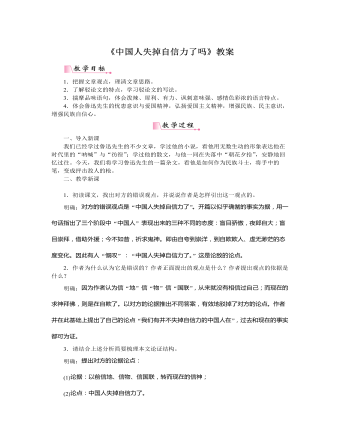
部编版语文九年级上册《中国人失掉自信力了吗》教案
一、导入新课我们已经学过鲁迅先生的不少文章,学过他的小说,看他用无数生动的形象表达他在时代里的“呐喊”与“彷徨”;学过他的散文,与他一同在失落中“朝花夕拾”,安静地回忆过往。今天,我们将学习鲁迅先生的一篇杂文,看他是如何作为民族斗士,将手中的笔,变成抨击敌人的枪。二、教学新课目标导学一:学习驳论,理清思路1.初读课文,找出对方的错误观点,并说说作者是怎样引出这一观点的。明确:对方的错误观点是“中国人失掉自信力了”。开篇以似乎确凿的事实为据,用一句话指出了三个阶段中“中国人”表现出来的三种不同的态度:盲目骄傲,夜郎自大;盲目崇拜,借助外援;今不如昔,祈求鬼神。即由自夸到崇洋,到自欺欺人、虚无渺茫的态度变化。因此有人“慨叹”:“中国人失掉自信力了。”这是论敌的论点。
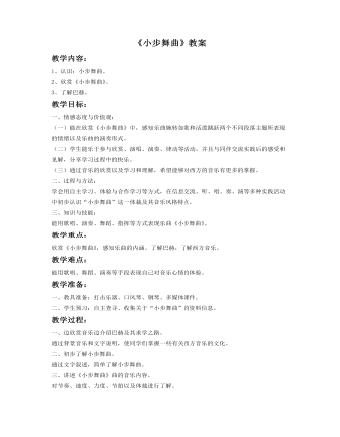
《小步舞曲教案》教案
教学过程:一、边欣赏音乐边介绍巴赫及其求学之路。通过背景音乐和文字说明,使同学们掌握一些有关西方音乐的文化。二、初步了解小步舞曲。通过文字叙述,简单了解小步舞曲。三、讲述《小步舞曲》曲的音乐内容。对节奏、速度、力度、节拍以及体裁进行了解。四、结合谱例分段学习《小步舞曲》。1、学习乐曲A’段。说明:依据乐曲创作背景,合理创设“舞会”情景,从而有效激发学生学习兴趣,用舞蹈表现手段演绎此乐段,发展了学生的舞蹈表演能力,享受到美的愉悦。2、学习乐曲B段。说明:利用形象、直观的图式辅助以及一系列贴近学生思维逻辑的问答讨论,激发学生的思考,帮助学生准确把握乐段情绪,并能用指挥、伴奏等方式表现该乐段。3、完整欣赏《小步舞曲》。说明:学生在完整欣赏乐曲时能够巩固乐曲主题的记忆,并且听辨、感受乐曲两个不同主题情绪,培养学生独立的音乐感受和见解。五、视频欣赏。说明:通过视屏欣赏,使同学们以一个更直观的郊区去理解和学习作品,并使同学对作品有更深刻的记忆。引起学生共鸣,领悟音乐的美感,愉悦身心,获取乐趣,从而激起学习的情趣。
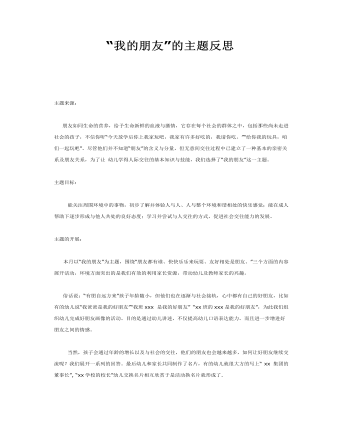
中班主题课件教案:“我的朋友”的主题反思
主题目标: 能关注周围环境中的事物,初步了解并体验人与人、人与整个环境和谐相处的快乐感觉;能在成人帮助下逐步形成与他人共处的良好态度;学习并尝试与人交往的方式,促进社会交往能力的发展。 主题的开展: 本月以“我的朋友”为主题,围绕“朋友都有谁、快快乐乐来玩耍、友好相处是朋友、”三个方面的内容展开活动,环境方面突出的是我们有效的利用家长资源,带动幼儿及教师家长的兴趣。 俗话说:“有朋自远方来”孩子年龄随小,但他们也在逐渐与社会接轨,心中都有自己的好朋友,比如有的幼儿说“我爸爸是我的好朋友”“我班xxx 是我的好朋友” “xx班的xxx是我的好朋友”,为此我们组织幼儿完成好朋友画像的活动。目的是通过幼儿讲述,不仅提高幼儿口语表达能力。而且进一步增进好朋友之间的情感。
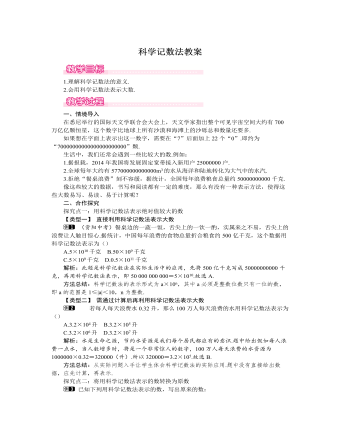
北师大初中七年级数学上册科学记数法教案1
解析:水是生命之源,节约水资源是我们每个居民都应有的意识.题中给出假如每人浪费一点水,当人数增多时,将是一个非常惊人的数字,100万人每天浪费的水资源为1000000×0.32=320000(升).所以320000=3.2×105.故选B.方法总结:从实际问题入手让学生体会科学记数法的实际应用.题中没有直接给出数据,应先计算,再表示.探究点二:将用科学记数法表示的数转换为原数已知下列用科学记数法表示的数,写出原来的数:(1)2.01×104;(2)6.070×105.解析:(1)将2.01的小数点向右移动4位即可;(2)将6.070的小数点向右移动5位即可.解:(1)2.01×104=20100;(2)6.070×105=607000.方法总结:将科学记数法a×10n表示的数,“还原”成通常表示的数,就是把a的小数点向右移动n位所得到的数.三、板书设计借助身边熟悉的事物进一步体会大数,积累数学活动经验,发展数感、空间感,培养学生自主学习的能力.
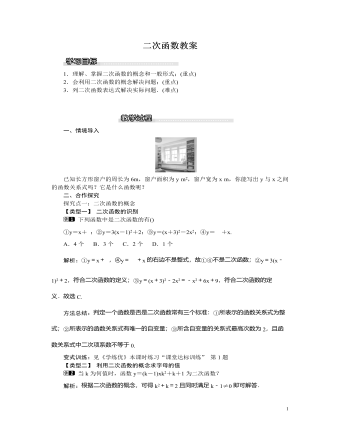
北师大初中九年级数学下册二次函数1教案
(2)由题意可得-10x2+180x+400=1120,整理得x2-18x+72=0,解得x1=6,x2=12(舍去).所以,该产品的质量档次为第6档.方法总结:解决此类问题的关键是要吃透题意,确定变量,建立函数模型.变式训练:见《学练优》本课时练习“课后巩固提升”第8题三、板书设计二次函数1.二次函数的概念2.从实际问题中抽象出二次函数解析式二次函数是一种常见的函数,应用非常广泛,它是客观地反映现实世界中变量之间的数量关系和变化规律的一种非常重要的数学模型.许多实际问题往往可以归结为二次函数加以研究.本节课是学习二次函数的第一节课,通过实例引入二次函数的概念,并学习求一些简单的实际问题中二次函数的解析式.在教学中要重视二次函数概念的形成和建构,在概念的学习过程中,让学生体验从问题出发到列二次函数解析式的过程,体验用函数思想去描述、研究变量之间变化规律的意义.
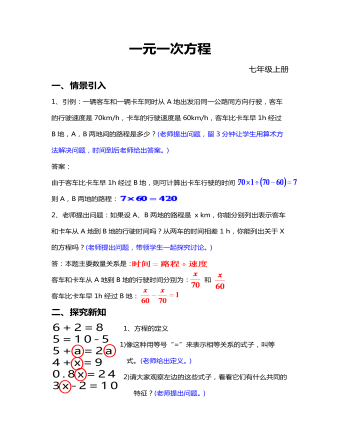
一元一次方程教案教学设计
1、方程的定义1)像这种用等号“=”来表示相等关系的式子,叫等式。(老师给出定义。)2)请大家观察左边的这些式子,看看它们有什么共同的特征?(老师提出问题。)3)列方程时,要先设字母表示未知数,然后根据问题中的相等关系,写出含有未知数的等式叫做方程。(学生思考后,老师给出新学内容方程的定义。)4)判断方程的两个关键要素: ①有未知数 ②是等式(老师提问,并给出。)
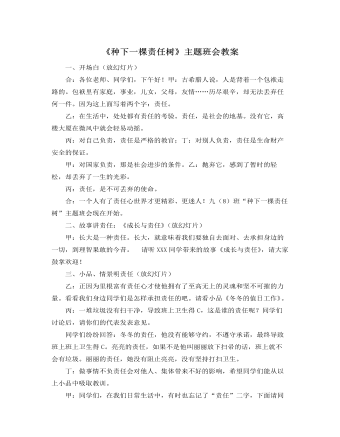
《种下一棵责任树》主题班会教案
情景剧(五)(放幻灯片)旁白:某年某月某日,君子上街买了一袋零食。晃悠在公园里:君子提着零食,边晃悠边吃花生。君子无视提示标语踏过草坪(草坪边标语:小草有生命,足下留情),剥掉的花生壳吧嗒吧嗒的丢在地上。这时,一个女孩走过来,叫住君子:“同学,老师说,不能随便乱扔垃圾!”君子回过头以不屑的目光从头到脚扫视了女生:“哼,你管不着,我爱怎么扔就怎么扔。”于是,继续吃着花生随地丢着花生壳。女孩子嘟着嘴,无奈地叹了叹,一颗一颗地拣起地上的花生壳。在旁边目睹了这一幕的老者叫住了君子:“小伙子,你东西掉了啦。”君子看了看自己提的袋子,又瞧了瞧路上:“没有啊,什么东西掉了?”老者感叹地说:“你的责任心掉了啦!”君子纳闷无语——(对社会负责)乙:大家欣赏了以上的情景剧,心里都有什么感受?情景剧(一)告诉我们要对学习负责,情景剧(二)告诉我们要对工作、对他人、对班集体负责情景剧(三)告诉我们要对家庭、对自己的生活负责情景剧(四)告诉我们要对校规、对自己身体健康负责情景剧(五)告诉我们要对社会负责
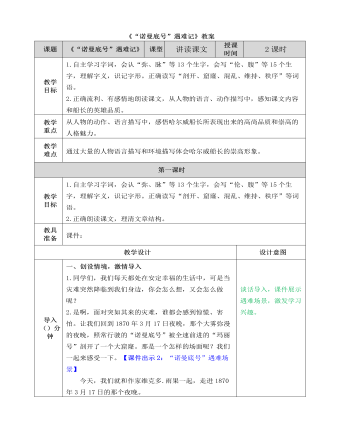
部编人教版四年级下册《 “诺曼底号”遇难记》教案
二、想象品读,体会惊恐万状的场面。1.【课件出示14】教师播放《泰坦尼克号》影片片断录音,学生倾听。2.听了刚才的场景,你感受如何?(好害怕,很恐惧等。)你们听到了什么?又仿佛看到了什么?(生自由回答)面对此情此景,你会首先想到什么呢?要实话实说。(活命、逃命、哭、什么也没想等。)3.师:那么“诺曼底号”上的人们又是怎么表现的呢?请同学们拿起笔,找出相关的段落。【课件出示15】震荡可怕极了。一刹那间,男人、女人、小孩,所有的人都奔到甲板上,人们半裸着身子,奔跑着,尖叫着,哭泣着,惊恐万状,一片混乱。海水哗哗往里灌,汹涌湍急,势不可当。轮机火炉被海浪呛得嘶嘶地直喘粗气。4.指名读文,其他评议。(1)指名学生读,从这段话中你体会到什么?(情况危急、场面混乱等),从哪些词语可以看出来?哪个词语最能体现出人们的表现?(板书:惊恐万状)(读)
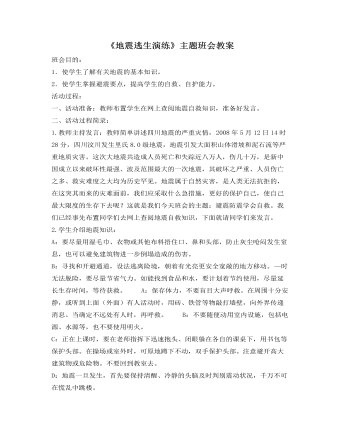
《地震逃生演练》主题班会教案
2.学生介绍地震知识:A:要尽量用湿毛巾、衣物或其他布料捂住口、鼻和头部,防止灰尘呛闷发生窒息,也可以避免建筑物进一步倒塌造成的伤害。B:寻找和开避通道,设法逃离险境,朝着有光亮更安全宽敞的地方移动。—时无法脱险,要尽量节省气力。如能找到食品和水,要计划着节约使用,尽量延长生存时间,等待获救。 A:保存体力,不要盲目大声呼救。在周围十分安静,或听到上面(外面)有人活动时,用砖、铁管等物敲打墙壁,向外界传递消息。当确定不远处有人时,再呼救。 B:不要随便动用室内设施,包括电源、水源等,也不要使用明火。C:正在上课时,要在老师指挥下迅速抱头、闭眼躲在各自的课桌下,用书包等保护头部。在操场或室外时,可原地蹲下不动,双手保护头部。注意避开高大建筑物或危险物。不要回到教室去。
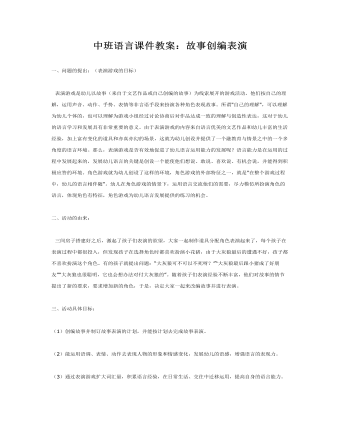
中班语言课件教案:故事创编表演
二、活动的由来: 三间房子搭建好之后,激起了孩子们表演的欲望,大家一起制作道具分配角色表演起来了,每个孩子在表演过程中都很投入,但发现孩子在选择角色时都喜欢扮演小花猪,由于大灰狼最后的遭遇不好,孩子都不喜欢扮演这个角色。有的孩子就提出问题:“大灰狼可不可以不死呀?”“大灰狼最后跟小猪成了好朋友”“大灰狼也很聪明,它也会想办法对付大灰狼的”。随着孩子们表演经验不断丰富,他们对故事的情节提出了新的要求,要求增加新的角色,于是,决定大家一起来改编故事并进行表演。三、活动具体目标:(1)创编故事并制订故事表演的计划,并能按计划去完成故事表演。(2)能运用语调、表情、动作去表现人物的形象和情感变化,发展幼儿的语感,增强语言的表现力。(3)通过表演游戏扩大词汇量,积累语言经验,在日常生活、交往中迁移运用,提高自身的语言能力。(4)培养幼儿自信、勇敢、大方的个性,能积极主动与人交谈、协商、合作与交往。
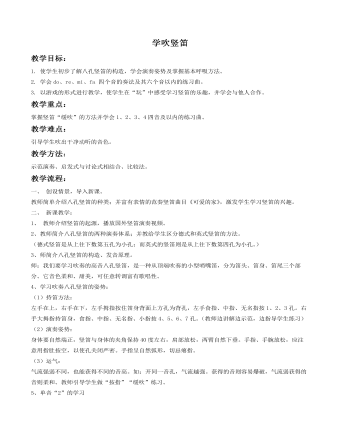
《竖笛演奏 送我一支玫瑰花》教案
一、 创设情景,导入新课。教师简单介绍八孔竖笛的种类;并富有表情的范奏竖笛曲目《可爱的家》,激发学生学习竖笛的兴趣。二、 新课教学:1、教师介绍竖笛的起源,播放国外竖笛演奏视频。2、教师简介八孔竖笛的两种演奏体系;并教给学生区分德式和英式竖笛的方法。(德式竖笛是从上往下数第五孔为小孔;而英式的竖笛则是从上往下数第四孔为小孔。)3、师简介八孔竖笛的构造、发音原理。师:我们要学习吹奏的高音八孔竖笛,是一种从顶端吹奏的小型哨嘴笛,分为笛头、笛身、笛尾三个部分。它音色柔和、甜美,可任意转调富有歌唱性。4、学习吹奏八孔竖笛的姿势:(1)持笛方法:左手在上,右手在下,左手拇指按住笛身背面上方孔为背孔,左手食指、中指、无名指按1、2、3孔。右手大拇指持笛身,食指、中指、无名指、小指按4、5、6、7孔。(教师边讲解边示范,边指导学生练习)

